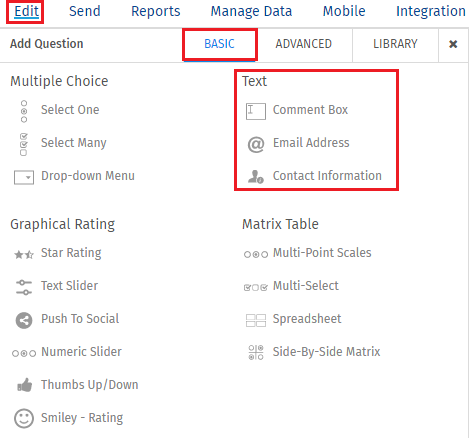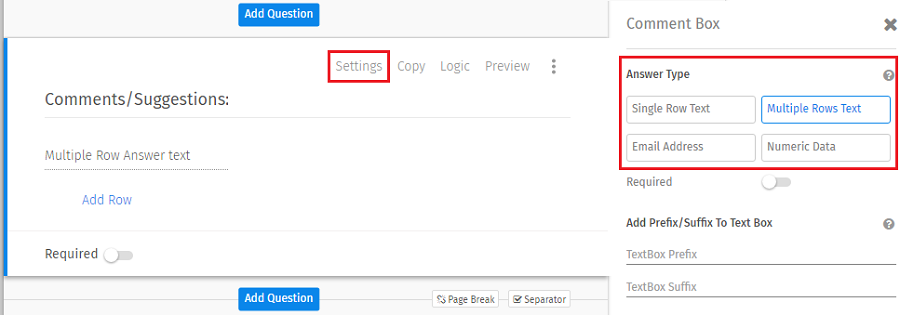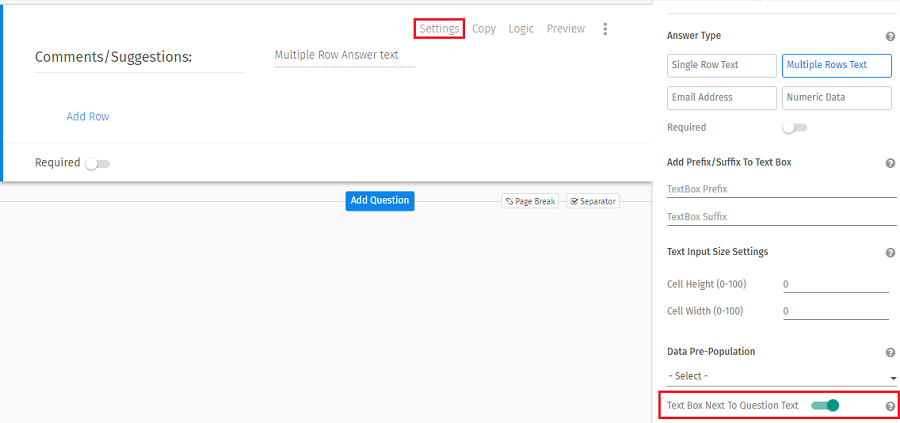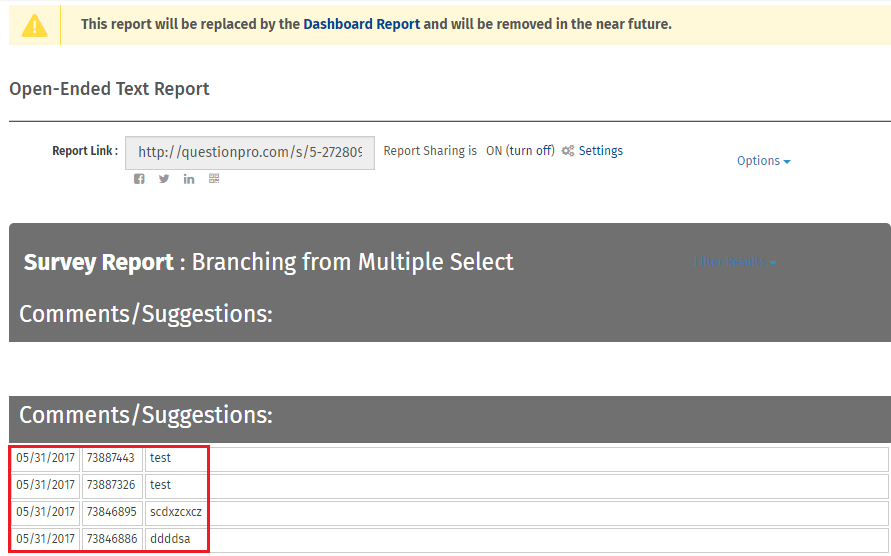
Watch the 1-minute tour
Open ended questions are defined as free-form survey questions that allows a respondent to answer in open text format such that they can answer based on their complete knowledge, feelings and understanding. This means that response to this question is not limited to a set of options.
Unlike a closed ended question that leaves survey responses limited and narrow to the given options, open-ended question allows
you to probe deep into the respondent's answers, gaining valuable information about the subject at hand.
The responses to these questions can be used to attain detailed and descriptive information on a subject.
Open ended questions are an integral part of Qualitative Market Research. This research technique depends heavily on open and subjective questions and answers on a given topic of discussion with room for further probing by the researcher, based on the answer given by the respondent. In a typical scenario, closed-ended questions are
used to gather qualitative data from respondents.
When designing surveys, we often need to decide whether to use an open ended question versus close ended
questions to get specific information. Yet we need to be aware of the fact that open ended question and
close ended questions each have their own strengths and weaknesses and perform in different ways.

Typical Open Ended Question asking for additional comments/suggestions
Respondents appreciate it more when they’re asked open-ended questions as that gives them 100% control over what they want to respond and they don’t feel restricted by the provided options. The beauty of open-ended questions is that they can never be one-word closed answer, they’ll either be in form of lists, some sentences or something longer like speech/paragraph.
So, to understand this more, here are some examples of open ended questions:
- Interview open ended question : How do you plan to use your existing skills to improve organizational growth, if hired?
- Customer facing open ended question : Please describe a scenario where our online market place helps you make day-to-day purchases.
- Technical open ended question : Can you please explain the back-end Javascript code template used for this webpage?
- Demographic open ended question : What is your age? (asked without survey options)
- Personal / Psychographic open ended question : How do you typically deal with stress and anxiety?
In a study conducted by the Pew Research in their November 2008 post-election survey, respondents were
asked, “What one issue mattered most to you in deciding how you voted for president?” One group was asked
this question in a close ended questions format while the other group was asked this question in an open
ended question format. The results are displayed below:
In the close ended questions format, 58% of respondents chose “The economy,” while in the
open-ended format only 35% wrote in a response that indicated “The economy.” Note also that in the close
ended questions format, only 8% of respondents selected “Other,” while in the open-ended format 43% of
respondents wrote in a response that would have been categorized as “Other.”
Open ended questions motivate the respondents to put their feedback into words without restricting their
thoughts. They aren’t as objective and dominant as close-ended questions.
By using open ended questions, the researcher gets to understand the true feelings their respondents
have. They have an element that will give you information about different thought processes across your
clientele, troubleshooting suggestions, get a peek into their inhibitions too.
- The open ended question and close ended questions are different tasks for respondents. In the
open-ended
task, respondents write down what is readily available in their minds, whereas in the close ended
questions task we have respondents focus their “attention on specific responses chosen by the
investigator,” (Converse and Presser, 1986).
- Asking the same question in these two different formats will almost always produce different
results.
Many investigators have demonstrated this over several decades.
- Few respondents are going to select the “Other” category and write in responses that are different
than
the answer choices that are listed.

So what does this mean for us? If you can, do qualitative research first and make sure your close ended
questions represent the items that are in people’s heads. We need the list of items to be complete since few
respondents will select the “Other” category. It may also be necessary to list items that are not readily
available to respondents if those items are important to you
Consider doing split sample studies where half of the respondents see the question in the open-ended format
while the other half sees the question in the close ended questions format.
When presenting results, I have found it helpful to explain to the audience, in a sentence or two, the
fundamental differences between open ended question and close ended questions. This helps them understand
that these are not necessarily precise measurements, but measurements that require some interpretation
relative to other questions in the survey and other information from qualitative research. Hence, that is
why they need an analyst like you or me!
- No limits on the answers: Happy or unhappy, the customers need a platform to voice their opinions.
As answer options for open ended questions aren’t provided, the respondent has the liberty to include
details about feelings, attitude and opinions that they usually wouldn’t get to submit in close-ended
questions.
- Medium for respondents to answer creatively: These questions are more appreciative of the
respondents than close-ended questions as users aren’t expected to just “fill” them out for the sake of
it.
Respondents may stun you with the vision and creativity they show with their answers. Links to their
personal blogs or a verse or two of their poetry will leave you spellbound.
- Expect the unexpected: If there are only close-ended questions in a survey, the users usually get
disconnected and fill it out without giving it much thought. With the kind of freedom that open ended
questions offer, users can respond the way they’d like to, be it the number of words or the details or
the tone of the message.
These responses may be marketing tips for the improvement of the branding of the organization or some
creative ideas that can lead to some monetary gains.
- Get answers to complicated situations: Knotty situations need feedbacks that are more than just a
mere Yes/No. Single select or Multi select questions can do no justice to the detail, scrutiny that’s
needed for some critical and complex situations.
Open ended questions work best in situations where the respondents are expected to explain their
feedback or describe the troubles they’re facing with the products.
- Understand your Clientele better: You can learn from your respondents. The open ended questions
offer the freedom to these respondents to be vocal about their opinion that would be insightful for
organizations.
Respondent logics, thoughts, language and reference choices can be known from these questions that can
reveal a lot about the way the respondent’s brain functions.
Always think before designing a survey as to what your objective is. Scrutinize the objective, evaluate the
positives and negatives of using an open or closed answer for your survey. Try it by sending out to a selected database, analyze the results and plan improvements for the next round of surveys.
Everything easy or complex requires competence. Asking the right question is also one such thing that requires capabilities. Capability to understand and segment the target audience, determine the kind of questions that will work well with that audience and determine the efficiency of open-ended questions.
Here are 4 ways to create effective open-ended questions:
- Why do you think competitive market research is important before launching a new business?
- How do you think you’ll overcome these obstacles in our project?
- Tell us about your experience with our onboarding process.
- What are your professional priorities at the moment?
- What domain of work motivates you?
- You can make a list of similar questions before you start executing the survey.
- Reconstruct any question into an open-ended question:
Observation is the key here. Observe what kind of questions do you usually ask your customers, prospects and every other person you come across. Analyze whether the questions you ask are closed ended or open ended. Try and convert those closed ended questions into open end ones wherever you think the latter would fetch you better results and valuable insights.
- Follow up a closed-ended question with an open-ended question:
This trick works wonders. It’s not always possible to convert a closed question into an open one but it’s definitely possible for you to follow up by getting a question that is open ended answered.
For example, if you have a closed question like - “Do you think the product was efficient?” with the options “Yes” and “No”, you can follow it up with an open question like “How do you think we can make the product better?”
When it comes to customer satisfaction surveys, the advantages of open questions surpass that of the closed ones.
To make the question mandatory you can click on Settings and you will find a toggle button to turn ON the
validation. WHY? When you add questions to a survey, by default, required option is turned off. When
required option is not enabled, respondents can continue with the survey without selecting answers. If
respondents go through all the pages in the survey without selecting answers, the response is still
considered as complete. You can enable required option to make a question required so that respondents can
continue with the survey only after responding to the questions.
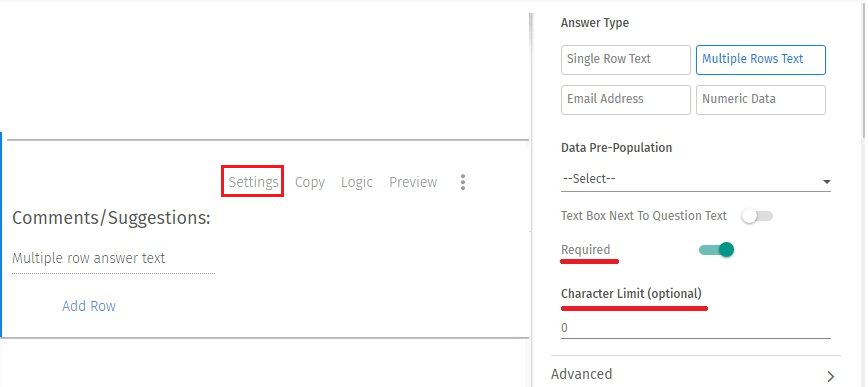
With many ways to create a survey and so many options for customization, whatever kind of
questionnaire you
need, QuestionPro can help you create it. If you're looking at other survey creators, think about these
following questions:
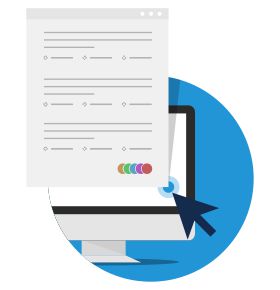
Create Open Ended Question Surveys
Quickly create open ended question surveys using our powerful web-based platform. You can
make a survey with your own questions, copy a professionally written open ended survey
template, or upload your survey with open ended questions directly from a Microsoft™ Word™ file.
QuestionPro has over 30 question types, advanced logic, dozens of color themes and other customization
options.

Collect Responses
Reach respondents wherever they are using our email distribution system, embedding in your
website or blog, with pop-up and exit questionnaires, promoting using our built-in QR Code generator or
posting to social networks like Facebook, Twitter and Google+. QuestionPro Questionnaires look great on
mobile devices or tablets, and you can even collect responses offline using our SurveyPocket iPad &
Android tablet or Smartphone app.

Analyze Results
With our full suite of reporting features such as real-time summary, pivot tables,
segmentation tools, trend analysis, and text analytics, analysis is efficient and effective. Need more
in-depth options to comb through the data? Export your survey data directly to Excel, SPSS, or CSV. And
it's easy to share results with formatted Word™ and PowerPoint™ reports or by generating great looking
infographics and word clouds.
Survey Software Easy to use and accessible for everyone. Design, send and analyze online surveys.
Research Suite A suite of enterprise-grade research tools for market research professionals.
Customer Experience Experiences change the world. Deliver the best with our CX management software.
Employee Experience Create the best employee experience and act on real-time data from end to end.






